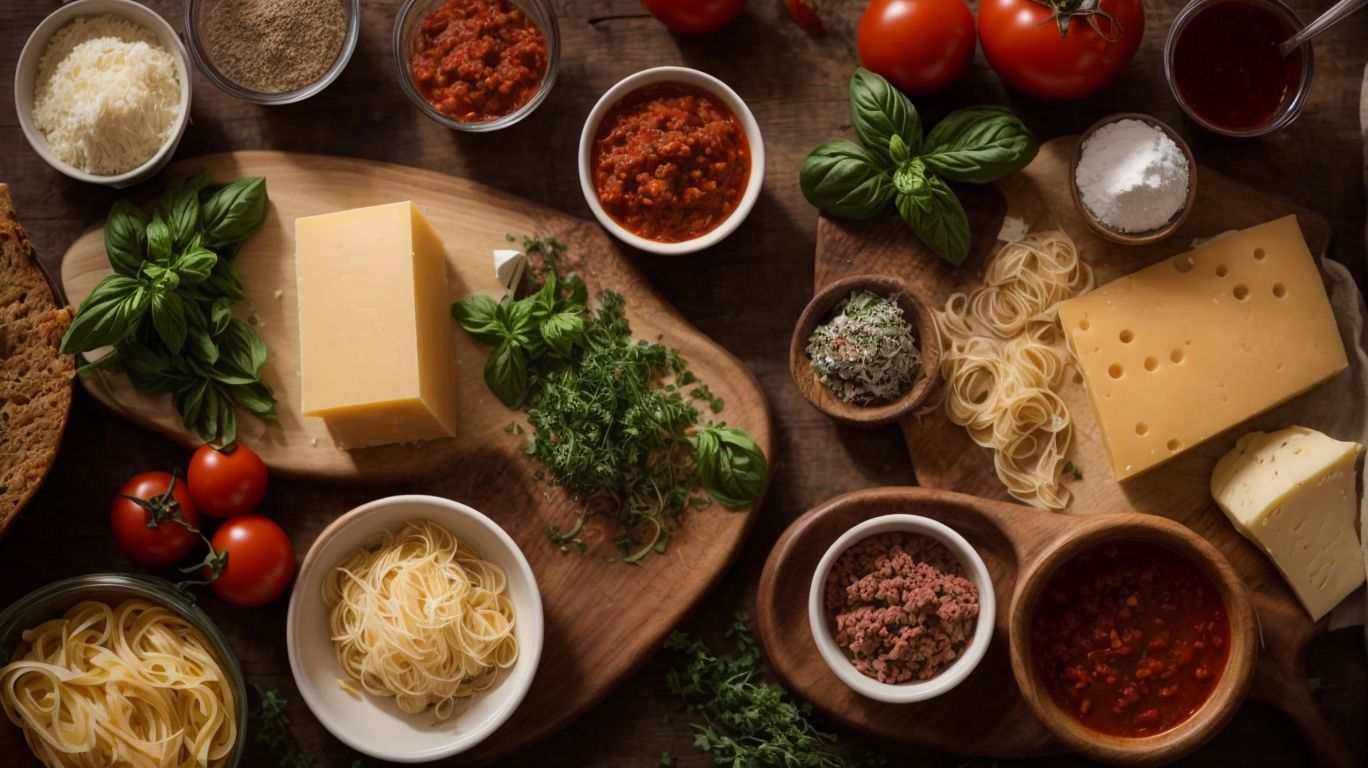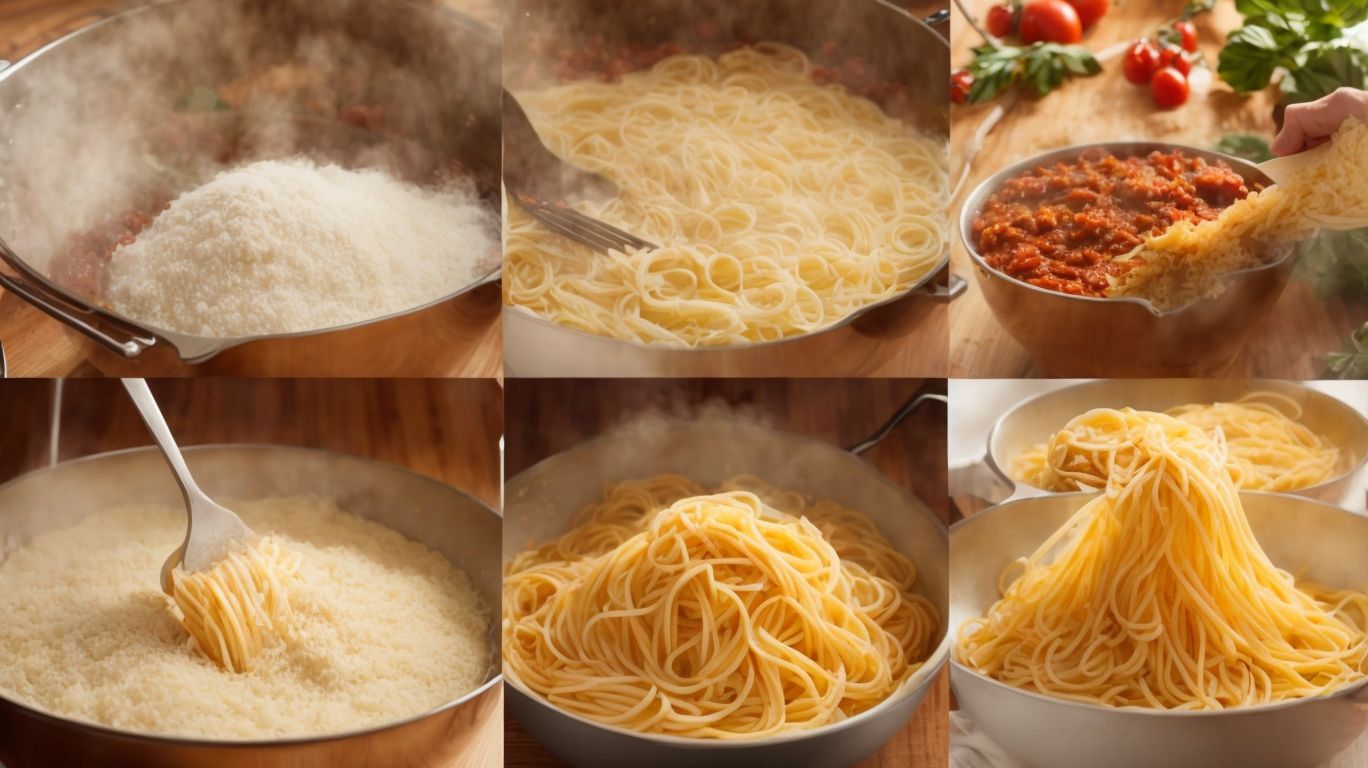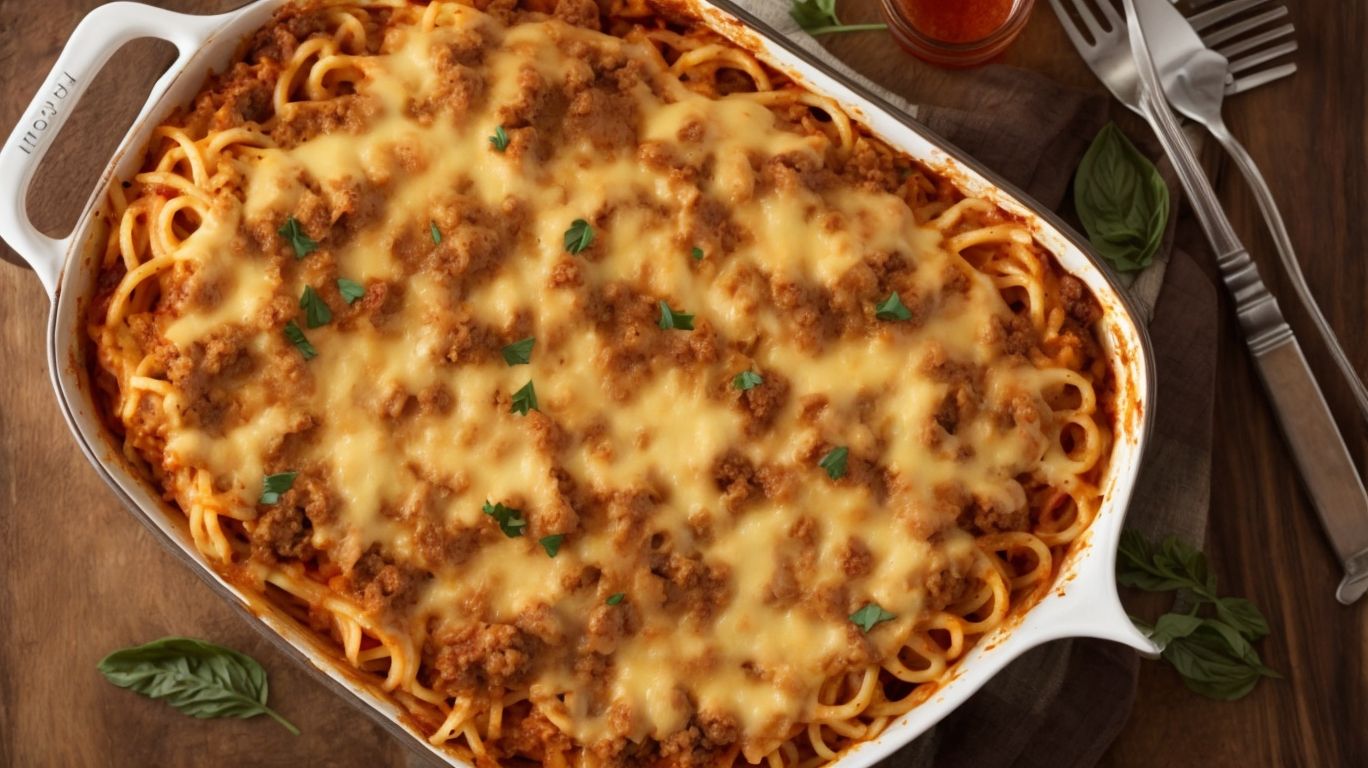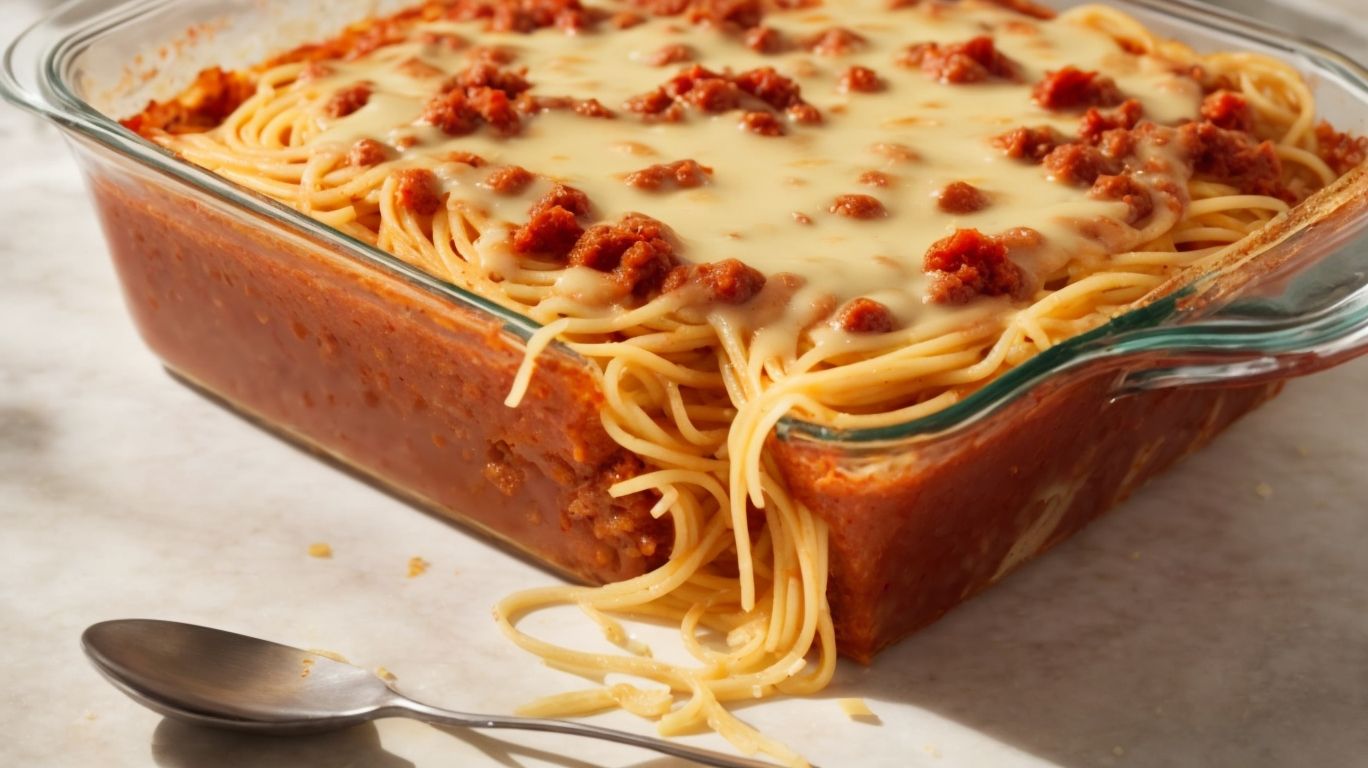How to Bake Spaghetti?
Are you tired of the same old spaghetti recipe? Looking to switch things up in the kitchen? Look no further!
In this article, we will explore the delicious world of baked spaghetti. From the ingredients needed to the step-by-step guide on how to bake this tasty dish, we have you covered.
Stay tuned for tips and tricks on how to achieve the perfect baked spaghetti and why baking it instead of boiling it can take your pasta game to the next level. Let’s get cooking!
Key Takeaways:
What is Baked Spaghetti?
Baked spaghetti is a delightful dish that combines the goodness of spaghetti noodles, savory meat sauce, and a generous topping of melted mozzarella and Parmesan cheeses, creating a comforting and cheesy casserole perfect for any meal.
What makes baked spaghetti so appealing is its versatility; you can customize it with your favorite ingredients to suit your taste preferences. The rich flavors from the slow-cooked meat sauce infuse into the tender spaghetti, creating a mouthwatering ensemble that pleases both young and old alike. With each layer of ingredients meticulously assembled, this dish offers a hearty and satisfying option that is also great for feeding a crowd.
Why Bake Spaghetti Instead of Boiling it?
Baking spaghetti instead of boiling it offers a unique twist to the classic pasta dish, resulting in a cheesy, baked creation that is simple to make and loved by many.
One of the key advantages of baking spaghetti lies in the convenience it offers. Unlike the traditional boiling method, where constant monitoring is required to prevent overcooking or sticking, baking allows for a more hands-off approach. This hands-free cooking method frees up time for other tasks or simply relaxing while waiting for the delicious dish to be ready.
Moreover, baking spaghetti unlocks the potential for richer, deeper flavors. The oven’s heat helps melt and blend the cheese with the pasta, creating a gooey, savory outcome that is hard to achieve through boiling alone. Each bite is an explosion of cheesy goodness, elevating the overall taste experience.
The appeal of a baked pasta dish extends beyond just the culinary aspect. The enticing aroma that fills the kitchen as the spaghetti bakes in the oven adds to the anticipation and excitement of the meal. The mesmerizing sight of golden-brown cheese bubbling on top enhances the visual appeal, making it a feast for both the eyes and the taste buds.
Ingredients Needed for Baked Spaghetti

Credits: Poormet.Com – Richard Lopez
To create a delicious baked spaghetti dish, you will need a blend of flavorful ingredients such as ground beef, onions, garlic, mozzarella, Parmesan cheese, basil, and a rich savory sauce.
What Type of Spaghetti Noodles to Use?
When preparing baked spaghetti, it is crucial to select high-quality spaghetti noodles that can withstand the baking process while maintaining their ideal texture and cooking time.
One of the key factors to consider when choosing spaghetti for baked dishes is the thickness of the noodles. Thicker spaghetti varieties tend to hold up better to the prolonged cooking times involved in baking, ensuring they don’t become mushy or overly soft.
The shape of the spaghetti noodles can also play a role in how well they retain their texture. Long, straight noodles are often preferred for baked dishes as they provide a satisfying mouthfeel and look visually appealing when served.
Remember, the right spaghetti choice can elevate your baked spaghetti dish to a whole new level, making it a delectable treat for pasta lovers everywhere.
What Type of Sauce to Use?
For a flavorful baked spaghetti, it is recommended to use a rich tomato-based sauce infused with aromatic garlic, onions, fresh basil, and a blend of savory cheeses, seasoned with Italian herbs for an authentic taste.
Regarding choosing the perfect tomato-based sauce for your baked spaghetti, a classic marinara sauce is a popular choice. The combination of ripe tomatoes, garlic, and onions cooked down with a hint of sweetness creates a rich and robust base for your dish. You can also opt for a spicy arrabbiata sauce, adding a kick of red pepper flakes for a fiery twist.
To elevate the flavors even further, consider incorporating sun-dried tomatoes into your sauce for a deep, concentrated taste that adds complexity to each bite. Another excellent option is a slow-cooked pomodoro sauce, allowing the flavors to intensify and meld together beautifully.
What Type of Meat to Use?
When preparing baked spaghetti, you can choose from a variety of meats such as flavorful ground beef, tender ground sausage, or lean ground turkey, allowing you to customize the dish according to your preferences.
Each meat option brings a unique taste profile to the dish. Ground beef adds richness and a hearty flavor, ground sausage introduces a hint of spice and savory notes, while ground turkey offers a lighter, healthier alternative.
By selecting the right meat, you can elevate the overall taste of your baked spaghetti, making it a crowd-pleasing favorite for family dinners or gatherings.
Experimenting with different meat combinations can also create a more complex flavor profile, adding depth and dimension to the dish.
Regardless of your choice, the meat plays a crucial role in enhancing the overall appeal of the baked spaghetti.
What Type of Cheese to Use?
To achieve that irresistible cheesy goodness in baked spaghetti, it is recommended to use a combination of melty mozzarella and flavorful Parmesan cheeses, creating a gooey and satisfying dish that everyone will love.
Regarding cheese selection, mozzarella is a top pick due to its fantastic melting capabilities, forming those delicious strings of cheese that tantalize the taste buds with every bite. In contrast, Parmesan adds a depth of flavor and a satisfying nuttiness to the dish, elevating the overall taste profile. The combination of these cheeses results in a perfect harmony of textures and tastes, making baked spaghetti a quintessential comfort food that satisfies cravings and brings people together over a shared love for all things cheesy.
Step-by-Step Guide on How to Bake Spaghetti

Credits: Poormet.Com – Wayne Thomas
Follow this step-by-step guide to create a mouthwatering baked spaghetti dish that involves cooking the spaghetti, preparing a flavorful meat sauce, layering the ingredients with cheese, and baking to perfection.
Step 1: Cook the Spaghetti Noodles
Begin the baked spaghetti preparation by cooking the spaghetti noodles according to package instructions until al dente, ensuring that the strands are firm yet tender enough to be easily pierced with a fork.
Once the noodles reach the desired texture, drain them in a colander, reserving some of the pasta water to adjust the consistency of the sauce later.
Next, preheat your oven to the specified temperature as per the recipe you are following for the baked spaghetti dish.
In a separate saucepan, prepare a flavorful meat sauce using ground beef, onions, garlic, and your choice of herbs and spices.
Cook the meat until it browns, then add tomato sauce and simmer to blend the flavors. Adjust seasoning to taste.
Step 2: Prepare the Meat Sauce
Next, craft a robust meat sauce for the baked spaghetti by sautéing garlic, onions, and aromatic basil in a savory tomato sauce seasoned with Italian herbs and a pinch of seasoned salt for added flavor.
To enhance the depth of flavors in the sauce, allow the garlic and onions to caramelize gently in the pan, releasing their rich, savory essence. The fragrant basil adds a fresh and herbaceous note, harmonizing with the other ingredients. The Italian herbs, such as oregano and thyme, bring a Mediterranean flair, perfectly complementing the tomatoes. Sprinkle a touch of seasoned salt to elevate the overall taste profile, balancing the sweetness of the tomatoes with a subtle savory kick.
Step 3: Layer the Spaghetti and Sauce
Create delicious layers of spaghetti, meat sauce, and cheese in a baking dish, ensuring each component is evenly distributed for a harmonious blend of flavors, herbs, and textures that will shine through when baked.
Start by boiling the spaghetti until it is al dente, then drain and toss it with a bit of olive oil to prevent sticking.
- Layer the bottom of the baking dish with a generous amount of meat sauce, ensuring to spread it evenly.
- Next, add a layer of cooked spaghetti on top of the meat sauce, creating a stable base for the dish.
- Sprinkle a handful of grated cheese over the spaghetti layer, allowing it to melt and create a gooey, savory coating.
Step 4: Top with Cheese and Bake
Finish off your baked spaghetti masterpiece by generously topping it with a blend of cheeses and baking it in the oven until golden and crispy, allowing the flavors to meld together beautifully.
For the cheese topping, consider using a mix of shredded mozzarella, Parmesan, and cheddar for a rich and gooey finish. Sprinkle the cheeses evenly over the spaghetti, ensuring every bite is packed with savory goodness.
Preheat your oven to 375°F (190°C) to achieve the perfect balance of melting the cheeses while crisping up the top layer. Bake the dish uncovered for approximately 25-30 minutes, or until the cheese is bubbling and starts to turn a luscious golden brown.
This baking process allows the cheeses to melt into the pasta, creating a creamy texture that contrasts wonderfully with the slightly crispy, browned topping. The result is a mouthwatering baked spaghetti dish that is sure to impress your family and friends.
Tips and Tricks for Perfect Baked Spaghetti

Credits: Poormet.Com – Eric Taylor
Ensure your baked spaghetti turns out perfectly every time with these expert tips and tricks that cover how to prevent the dish from drying out, enhance its flavor profile, and incorporate innovative ingredients like spaghetti squash and fresh herbs for added zest.
How to Prevent the Spaghetti from Drying Out?
To prevent baked spaghetti from drying out, consider adding a touch of moisture through ingredients like eggs, fresh herbs, or a sprinkle of seasoned salt, ensuring each bite remains succulent and flavorful.
Another excellent way to enhance the moisture content of your baked spaghetti is by incorporating a rich and creamy cheese sauce into the dish. The cheese not only adds a velvety texture but also contributes to locking in the moisture, keeping the spaghetti tender.
Incorporating vegetables such as diced tomatoes, bell peppers, or zucchini can add both moisture and additional flavor dimensions to your dish. These veggies release their natural juices as they bake, infusing the spaghetti with extra succulence.
How to Add Extra Flavor to the Dish?
Enhance the flavor profile of your baked spaghetti by experimenting with additional ingredients such as garlic, onions, fresh basil, herb seasoning, or an extra layer of savory cheese to elevate the taste and complexity of the dish.
Another way to add a burst of flavor to your baked spaghetti is by incorporating sun-dried tomatoes for a rich and tangy undertone. Consider including a sprinkle of red pepper flakes for a subtle kick of heat. Mixing in some roasted red peppers or olives can provide a depth of taste and a hint of sweetness.
- For cheese enthusiasts, try introducing a blend of mozzarella, parmesan, and asiago for a gooey and nutty finish to your dish.
- You can also experiment with different types of pasta shapes like penne or rotini to create a unique texture and mouthfeel.
Conclusion
Baked spaghetti offers a delightful culinary experience that combines the best of pasta, meat sauce, and cheese in a comforting casserole, making it a versatile and beloved dish for any meal.
Baked spaghetti is a popular choice for gatherings, potlucks, or simply cozy family dinners. Its appeal lies in the layers of flavors created by the melding of pasta, savory meat sauce, and gooey cheese, baked to golden perfection.
The dish is highly customizable, allowing for variations with different types of cheeses, meats, and even vegetables. This versatility makes it suitable for catering to various preferences and dietary restrictions.
Whether served as a main course alongside a fresh salad or as a comforting leftover meal the next day, baked spaghetti never fails to bring satisfaction and warmth to the table.
Final Thoughts on Baking Spaghetti
As you embark on your culinary journey of baking spaghetti, remember that this cheesy and flavorful dish is more than just a meal—it’s an expression of love and creativity that can be enjoyed by all.
When you take the time to mix the ingredients, layer the pasta with the rich sauce, and let it bake in the oven, it’s not just a recipe; it’s a symphony of flavors coming together to create a masterpiece.
The aroma that fills your kitchen as the spaghetti bakes can transport you to a cozy Sunday dinner with your loved ones, evoking cherished memories and creating new ones.
Every bite of the cheesy, gooey goodness can warm your heart and soul, a reminder that simple ingredients combined with care can result in pure magic.
Frequently Asked Questions
How do I bake spaghetti?
To bake spaghetti, start by boiling the noodles until they are al dente. Then, mix them with your desired sauce and place in a baking dish. Top with cheese and bake in the oven until bubbly and golden brown.
Can I use regular spaghetti noodles for baking?
Yes, regular spaghetti noodles can be used for baking. Just make sure to cook them al dente before mixing with your sauce and baking in the oven.
What type of sauce should I use for baked spaghetti?
You can use any type of sauce for baked spaghetti, such as marinara, meat sauce, or Alfredo. It all depends on your personal preference.
Can I add vegetables to my baked spaghetti?
Absolutely! Adding vegetables like bell peppers, mushrooms, and onions can add extra flavor and nutrition to your baked spaghetti dish.
How long does it take to bake spaghetti?
Generally, baked spaghetti takes about 20-30 minutes in the oven at 375 degrees Fahrenheit. However, the exact time may vary depending on your oven and the size of your baking dish.
Can I make baked spaghetti ahead of time?
Yes, you can prepare your baked spaghetti ahead of time and store it in the fridge until you are ready to bake it. Just make sure to cover it with foil and increase the baking time to ensure it is heated through.

